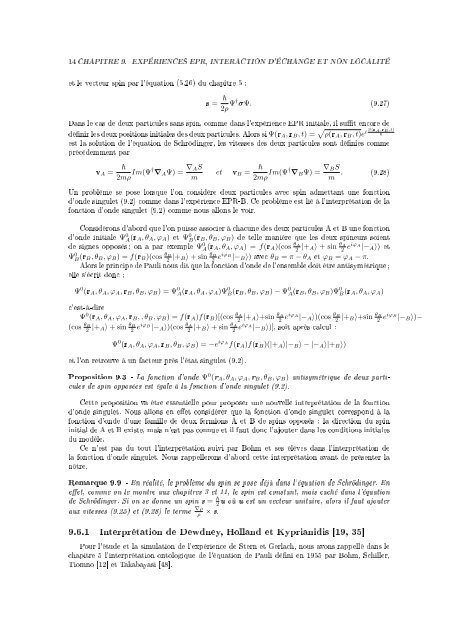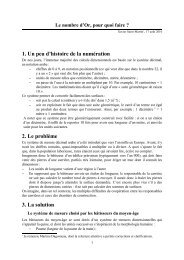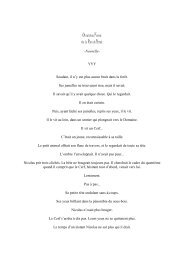Expériences EPR, interaction d'échange et non localité - Admiroutes
Expériences EPR, interaction d'échange et non localité - Admiroutes
Expériences EPR, interaction d'échange et non localité - Admiroutes
You also want an ePaper? Increase the reach of your titles
YUMPU automatically turns print PDFs into web optimized ePapers that Google loves.
14 CHAPITRE 9. EXPÉRIENCES <strong>EPR</strong>, INTERACTION D'ÉCHANGE ET NON LOCALITÉ<br />
<strong>et</strong> le vecteur spin par l'équation (5.26) du chapitre 5 :<br />
s = 2ρ Ψ† σΨ. (9.27)<br />
Dans le cas de deux particules sans spin, comme dans l'expérience <strong>EPR</strong> initiale, il sut encore de<br />
dénir les deux positions initiales des deux particules. Alors si Ψ(r A ,r B , t) = √ ρ(r A ,r B , t)e i S(r ,r A B ,t)<br />
<br />
est la solution de l'équation de Schrôdinger, les vitesses des deux particules sont dénies comme<br />
précèdemment par<br />
v A =<br />
<br />
2mρ Im(Ψ† ∇ A Ψ) = ∇ AS<br />
m<br />
<strong>et</strong> v B = <br />
2mρ Im(Ψ† ∇ B Ψ) = ∇ BS<br />
m . (9.28)<br />
Un problème se pose lorsque l'on considère deux particules avec spin adm<strong>et</strong>tant une fonction<br />
d'onde singul<strong>et</strong> (9.2) comme dans l'expérience <strong>EPR</strong>-B. Ce problème est lié à l'interprétation de la<br />
fonction d'onde singul<strong>et</strong> (9.2) comme nous allons le voir.<br />
Considérons d'abord que l'on puisse associer à chacune des deux particules A <strong>et</strong> B une fonction<br />
d'onde initiale Ψ 0 A (r A, θ A , ϕ A ) <strong>et</strong> Ψ 0 B (r B, θ B , ϕ B ) de telle manière que les deux spineurs soient<br />
de signes opposés; on a par exemple Ψ 0 A (r A, θ A , ϕ A ) = f(r A )(cos θ A<br />
2<br />
|+ A 〉 + sin θ A<br />
2<br />
e iϕ A<br />
|− A 〉) <strong>et</strong><br />
Ψ 0 B (r B, θ B , ϕ B ) = f(r B )(cos θ B<br />
2<br />
|+ B 〉 + sin θ B<br />
2<br />
e iϕ B<br />
|− B 〉) avec θ B = π − θ A <strong>et</strong> ϕ B = ϕ A − π.<br />
Alors le principe de Pauli nous dit que la fonction d'onde de l'ensemble doit être antisymétrique;<br />
elle s'écrit donc :<br />
Ψ 0 (r A , θ A , ϕ A ,r B , θ B , ϕ B ) = Ψ 0 A(r A , θ A , ϕ A )Ψ 0 B(r B , θ B , ϕ B ) − Ψ 0 A(r B , θ B , ϕ B )Ψ 0 B(r A , θ A , ϕ A )<br />
c'est-à-dire<br />
Ψ 0 (r A , θ A , ϕ A ,r B , , θ B , ϕ B ) = f(r A )f(r B )[(cos θ A<br />
2<br />
|+ A 〉+sin θ A<br />
2<br />
e iϕ A<br />
|− A 〉)(cos θ B<br />
2<br />
|+ B 〉+sin θ B<br />
2<br />
e iϕ B<br />
|− B 〉)−<br />
(cos θ B<br />
2<br />
|+ A 〉 + sin θ B<br />
2<br />
e iϕ B<br />
|− A 〉)(cos θ A<br />
2<br />
|+ B 〉 + sin θ A<br />
2<br />
e iϕ A<br />
|− B 〉)], soit après calcul :<br />
Ψ 0 (r A , θ A , ϕ A ,r B , θ B , ϕ B ) = −e iϕ A<br />
f(r A )f(r B )(|+ A 〉|− B 〉 − |− A 〉|+ B 〉)<br />
<strong>et</strong> l'on r<strong>et</strong>rouve à un facteur près l'état singul<strong>et</strong> (9.2).<br />
Proposition 9.3 - La fonction d'onde Ψ 0 (r A , θ A , ϕ A ,r B , θ B , ϕ B ) antisymétrique de deux particules<br />
de spin opposées est égale à la fonction d'onde singul<strong>et</strong> (9.2).<br />
C<strong>et</strong>te proposition va être essentielle pour proposer une nouvelle interprétation de la fonction<br />
d'onde singul<strong>et</strong>. Nous allons en e<strong>et</strong> considérer que la fonction d'onde singul<strong>et</strong> correspond à la<br />
fonction d'onde d'une famille de deux fermions A <strong>et</strong> B de spins opposés : la direction du spin<br />
initial de A <strong>et</strong> B existe, mais n'est pas connue <strong>et</strong> il faut donc l'ajouter dans les conditions initiales<br />
du modèle.<br />
Ce n'est pas du tout l'interprétation suivi par Bohm <strong>et</strong> ses élèves dans l'interprétation de<br />
la fonction d'onde singul<strong>et</strong>. Nous rappellerons d'abord c<strong>et</strong>te interprétation avant de présenter la<br />
nôtre.<br />
Remarque 9.9 - En réalité, le problème du spin se pose déjà dans l'équation de Schrödinger. En<br />
e<strong>et</strong>, comme on le montre aux chapitres 3 <strong>et</strong> 11, le spin est constant, mais caché dans l'équation<br />
de Schrödinger. Si on se donne un spin s = 2u où u est un vecteur unitaire, alors il faut ajouter<br />
aux vitesses (9.25) <strong>et</strong> (9.28) le terme ∇ρ<br />
ρ × s.<br />
9.6.1 Interprétation de Dewdney, Holland <strong>et</strong> Kyprianidis [19, 35]<br />
Pour l'étude <strong>et</strong> la simulation de l'expérience de Stern <strong>et</strong> Gerlach, nous avons rappellé dans le<br />
chapitre 5 l'interprétation ontologique de l'équation de Pauli déni en 1955 par Bohm, Schiller,<br />
Tiomno [12] <strong>et</strong> Takabayasi [48].





